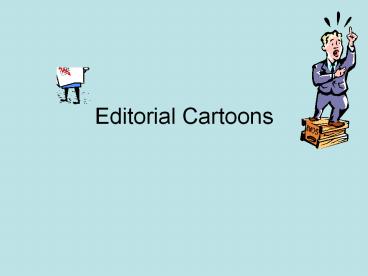Editorial Cartoons - PowerPoint PPT Presentation
1 / 31
Title: Editorial Cartoons
1
Editorial Cartoons
2
What is an editorial cartoon?
- Editorial cartoons are comics with a purpose.
- Also called political cartoons, they make a
comment about issues in the news - Editorial cartoons are opinion-based. They have a
point of view. Not objective.
3
Why are they effective?
- Visually powerful.
- Quick and easy to read people who wont read an
entire editorial will glance at a cartoon - Easy to understand theyre not often subtle, so
most people get the message quickly
4
- The combination of words and images gives an
editorial cartoonist a unique way of commenting
on the news. - Because he or she isnt obligated to be
objective, a good cartoonist can sway public
opinion about an issue.
5
What makes editorial cartoons effective?
6
Editorial Techniques
- Good editorial cartoonists rely on a toolkit of
persuasive and artistic techniques to generate a
response in the reader. - When used effectively, the techniques discussed
on the following slides can create strong
emotional and logical responses in a reader.
7
- Many cartoonists are interested in starting a
debate or a discussion. - You may not agree with the opinion presented, but
if it prompts you to talk about it, it can be
considered a success. Editorial cartoonists want
to influence the public discourse.
8
Symbolism
- One thing stands in for something else. Editorial
cartoons rely on images. There isnt time or
space to use enough text to explain complex
issues. - As a result, a complex issue or a large group of
diverse people may be distilled down to a single
image.
9
What do these symbolize?
- A dove?
- A beaver?
- Uncle Sam?
- A bull and a bear?
- A white flag?
- Peace
- Canada
- The U.S.A.
- The stock market
- Surrender
10
(No Transcript)
11
(No Transcript)
12
Exaggeration / Distortion
- Certain elements of the visual are distorted to
draw extra attention to them. - What is distorted and how it is distorted will
depend largely on the effect the artist hopes to
create.
13
- For example, a politician or country that is
acting like a bully might be made
disproportionately huge. - An overwhelming underdog might be made just as
disproportionately small.
14
(No Transcript)
15
(No Transcript)
16
Stereotypes
- Stereotypes are more often than not insulting,
generalizations that may or may not have any
basis in fact. - That said, they can be put to incredibly
effective use by immoral and/or unscrupulous
people. - Some stereotypes are less negative and can be
used by the artist to create humour, etc.
17
(No Transcript)
18
Caricature
- Caricatures help us identify news figures quickly
by emphasizing and exaggerating the most
recognizable features of the person. - Caricatures are not always flattering, but make
it clear who the artist is drawing, even if his
or her artistic skills are limited.
19
(No Transcript)
20
(No Transcript)
21
Humour and Irony
- Humour can sometimes take the edge off a serious
or controversial subject. - Humour can also be used to ridicule a person,
group or issue that that the artist believes to
be embarrassing or wrong.
22
- By making people laugh at something, the artist
has the power to make it less powerful. - Irony (a statement that is the opposite of what
is meant) can also be used to draw attention to
an issue that is important to the artist.
23
(No Transcript)
24
(No Transcript)
25
Captions and Labels
- Words can be used (very few words, however) to
emphasize or explain some aspect of the drawing. - The artist may also use captions and labels to
make it completely clear who or what is pictured
in the drawing. - A picture may be worth a thousand words, but
sometimes one or two more words make the picture
worth even more.
26
(No Transcript)
27
(No Transcript)
28
(No Transcript)
29
Analyzing Cartoons
- Part I - Choose one of the cartoons in this
PowerPoint and find another cartoon of your own
choosing from one of the following sites - http//cagle.msnbc.com/
- http//www.canadiancartoonists.com/
- Complete the Political Cartoon Analysis sheet
provided
30
- Complete the following for one of the two
cartoons youve analyzed - Briefly describe the cartoon
- What issue is being addressed?
- List the key objects in the cartoon
- What is the cartoons message? In other words,
how do you think the cartoonist feels about the
issue? (What gives away his or her bias?)
31
- Is the artist successful in sending the message?
Is the cartoon effective? Why or why not? - Is there any person or group that might be
particularly offended by this cartoon? Would they
be justified in this feeling? - Submit the final product via email
jamiemac_at_staff.ednet.ns.ca































